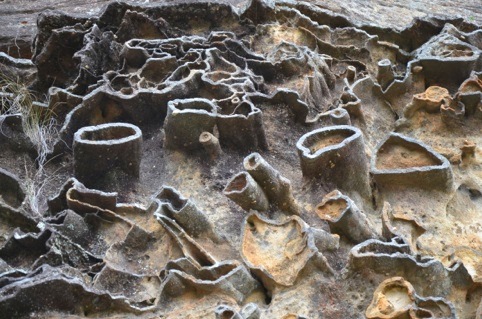
Ironstone fulgurite tubes. Blue Mountains, Australia
Original Post February 14, 2014
Strange formations within a sandstone matrix are found throughout the Blue Mountains.
Exactly what are sandstone and ironstone? The classic explanation is that they are both sedimentary rock, which means they are deposited in layers.
In the Blue Mountains near Sydney, the sandstone layer is around 600 meters thick, part of a mountain range 1000 meters above sea level. If it was deposited as a sediment, it means that some time in the past the area was under water and was subsequently pushed up, somehow. The question is, if it was under water, how was it deposited? It had to flow from somewhere higher to get where it is now.
Most of the Eastern coast of Australia is sandstone. Theoretically, water deposited the sediment, creating a vast, smooth plain under water. It then must have been pushed up over 1000 meters without cracking or falling apart (rock is brittle), leaving a mountain range that was then dissected by water. So, after millions of years of water cutting through the sandstone plateau, (nowhere near enough surface area for water to run off and do this), the sediment was again washed-out onto the plains. However, a question no one asks is: what volume of water is needed to cut valleys covering thousands of square kilometers, and then carry the sediment hundreds of kilometers away?
Ironstone formation is part of the same story. It is supposed to be sandstone that has been layered with iron oxide, forming a harder layer. If that is the case, how to explain the picture above? What process can form ironstone in tubular sections running through a mountain? Definitely not through sedimentation.
Based on the physical evidence, the tubular formations are fulgurites. They are only caused by one process: electricity, or lightning discharges. Normally, fulgurites are found near the surface and are small. How can lightning form tubular fulgurites through a mountain? The largest one in the photo above is almost 500 millimeters in diameter.
Is it possible that another method created the sandstone and ironstone tubes and layers? For those who see plasma geology as a viable alternative to wind, water and tectonic forces, sandstone is the result of plasma discharges carving this planet on a scale we cannot comprehend. Massive volumes of dust were ejected from the electric arcs, settling over a vast area. The particles carried a charge that bonded them together. No need for them to be compressed together by additional layers of rock under large amounts of water.
Ironstone is where electrical charges traveled through the sandstone, melting it into layers. The layers are sometimes flat, and sometimes folded into unusual shapes, forming fulgurites as shown above.
With eyes to see, it seems apparent that the process of plasma geology has not just happened once on this planet. The problem is that we do not really look at the evidence, but would rather believe theories from a textbook rather than what is right in front of us.
Garry Maxfield












